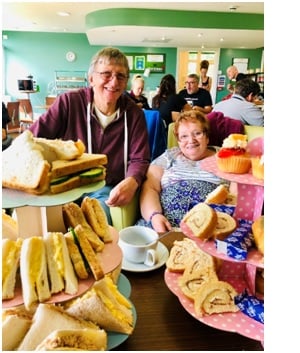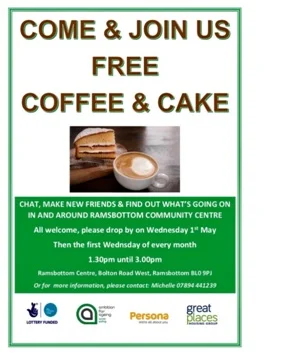Ambition for Ageing Bury
The Ambition for Ageing Social Eating programme seeks to increase the number of opportunities for older people to come together and eat communally in Greater Manchester, thereby creating a range of social occasions where people feel they belong and can make new friends with whom they can eat regularly. These are very significant factors in reducing social isolation among the over 50s - an increasing evidence base tells us that communal eating increases social bonding, feelings of well-being and enhances people’s connections to their communities.
Groundwork has been leading the social eating project in Bury and they have shared their findings with us about what makes a successful social eating project or event.
What are the notable features or characteristics that make a successful social eating project or event?
- Passionate
In order to create a successful project and make a positive impact on older people’s lives we have to be passionate about the value of social eating. This passion will drive your project forward and ensure you achieve the successful outcomes you are hoping for. Passion is also infectious and other people will want to get involved and make a positive contribution too.
- Person-centred
It is essential that any social eating projects are about the older people we are creating them for. They are the people who know what they want, what they need and they will keep coming along because they enjoy it. As part of our person-centred approach, we need to also empower our older people, so they take ownership of the project and tell others about it too. This is very important if we want to create sustainable projects that can grow, have an ongoing positive impact and help prevent social isolation over the long term.
- Adaptable
We have learnt from our projects in Bury that a successful social eating project must be adaptable and able to embrace change. We have had to adapt and change all of our projects in a variety of areas and for a range of reasons.
We chose to change the launch date of our Radcliffe project when marketing materials were delayed, however this allowed us more time to target more people and have a more successful launch event.

After speaking to local people in Ramsbottom, we changed the name of our project there from Bramble Place to Ramsbottom Community. This was because we didn’t want people to think it was an activity exclusively for residents in and around the immediate locality of Bramble Place and it helped up effectively reach a wider group from across Ramsbottom.
The allotment sight for our East Ward project was not really suitable in the current state and we were restricted is when we could deliver our social eating project to meet the needs of our target audience. By changing the venue temporarily until essential renovations have taken place, has helped us positively engage local people and helped attract further funding to carry out works and ensure long term sustainability.
In addition we have had key partners changing jobs or leaving communities, which could have had a big impact on our social eating projects but by embracing these changes in a positive way, our projects continue to grow.
4.Creative
As every locality and every group of people are different, we have learnt that every social eating project will also be different. Although we can adopt a specific set of principles and develop generic social eating model, we feel a successful project will only be achieved if we are also creative in meeting the needs of older people in our specific area.
In Bury we got creative in how we effectively engaged people:
In Ramsbottom we got our partners at Great Places Housing to text and email local residents and we got partners at Persona Care and Support to do a local leaflet drop, while we also used social media and put posters up. Whilst this worked in this area, we didn’t have the same partner resources available in another area, so had to come up with a different approach.
In East Ward a more deprived part of Bury we were fortunate to get a local shop and café to help us effectively engage as the know the local people and know who are at risk of social isolation. We also got the local counsellor to champion our project and specifically target those most at risk in the local area.
Another way we have been creative is in the language we use: initially, we found most older people were not interested in volunteering within a social eating project but when we asked for help with something, we had lots of offers.

5. Embrace Learning.
We also feel it is very important to embrace any learning, as not all social eating projects may be an instant success but if we embrace learning and meet the needs of local people, we can change things.
We have learnt a lot from our lunch and learn social eating project which is the only one of our Social Eating Projects in Bury that is service led. We involved key partners in the planning and design stages. The valuable project was designed so some of our most socially isolated residents and those at most risk of malnutrition and dehydration, could be referred by medical practitioners onto our ‘Lunch and Learn’ Social Eating Project. Where they could learn how to easily improve their food content, eat with others on the programme and build social connections. This would hopefully have a very positive impact on health and well-being. Although we thought this was a very valuable social eating project, we did not get the referrals or take up of the program and it was not worth us funding Bury Adult Learning to run it.
However, as a committed collaboration of partners, we could all still see the health benefits and potential for older people the valuable social eating program could bring – So rather than not progress with it we decided to embrace the learning and take it back to the planning and design stage. This time rather than service providers being involved in these stages, we involved focus groups of older people. Here is what we learnt from them:
The language we had used was wrong – They did not want to lunch and learn at this stage in their life and thought to suggest this was more of an insult than inviting.
They thought marketing directly to older people rather than being referred by a health professional would work better as it would be something they chose to do rather than being advised. There were also concerns raised that if an older person was poorly they may not be interested in attended a lunch and learn program at that particular time.
We also got the marketing wrong: they didn’t like the poster; it was too formal looking and not inviting.
We massively embraced all of this learning and with their help redesigned it. Our exciting newly designed social eating program ‘Come Dine with Me’ has been relaunched and is already half full.

